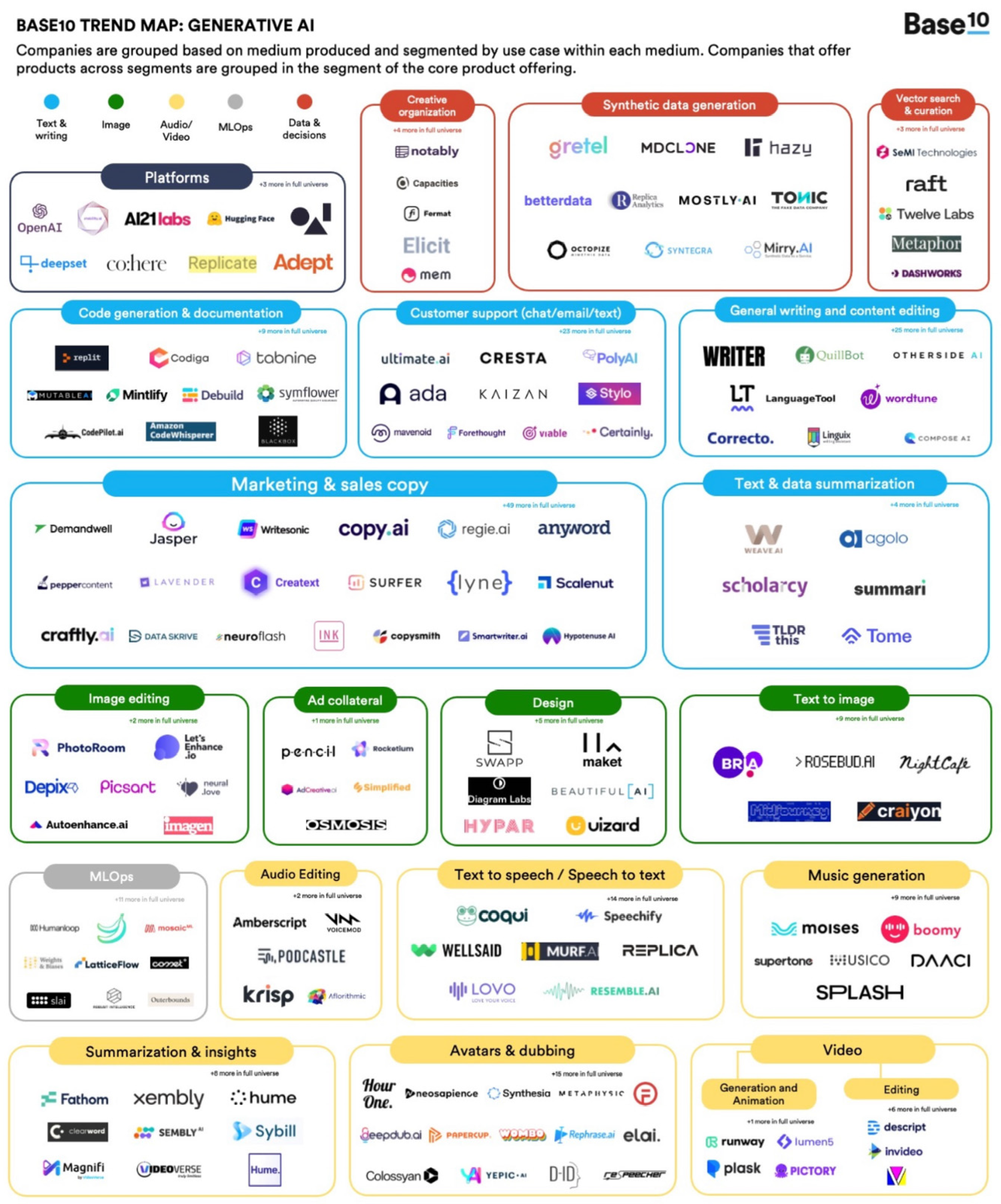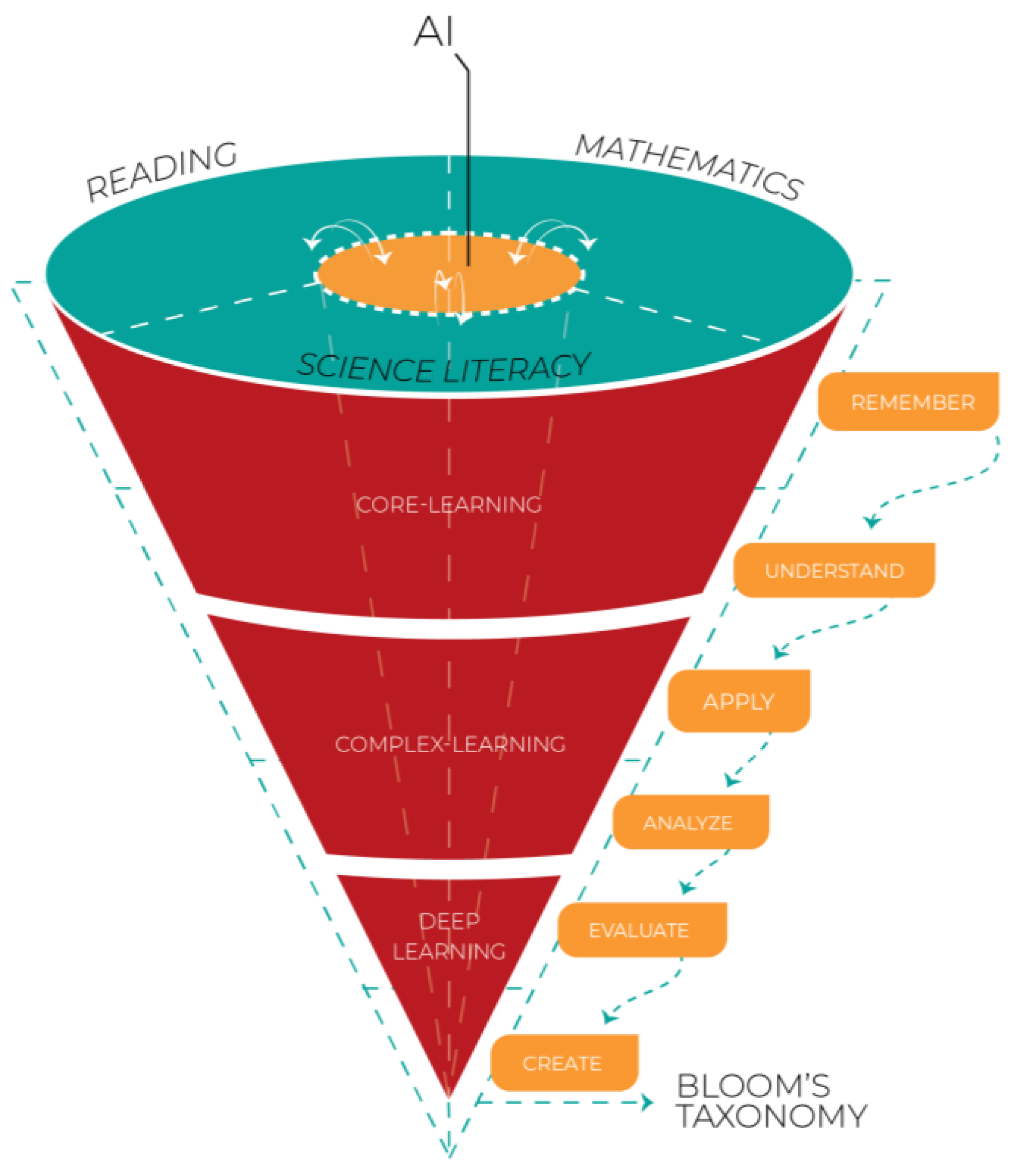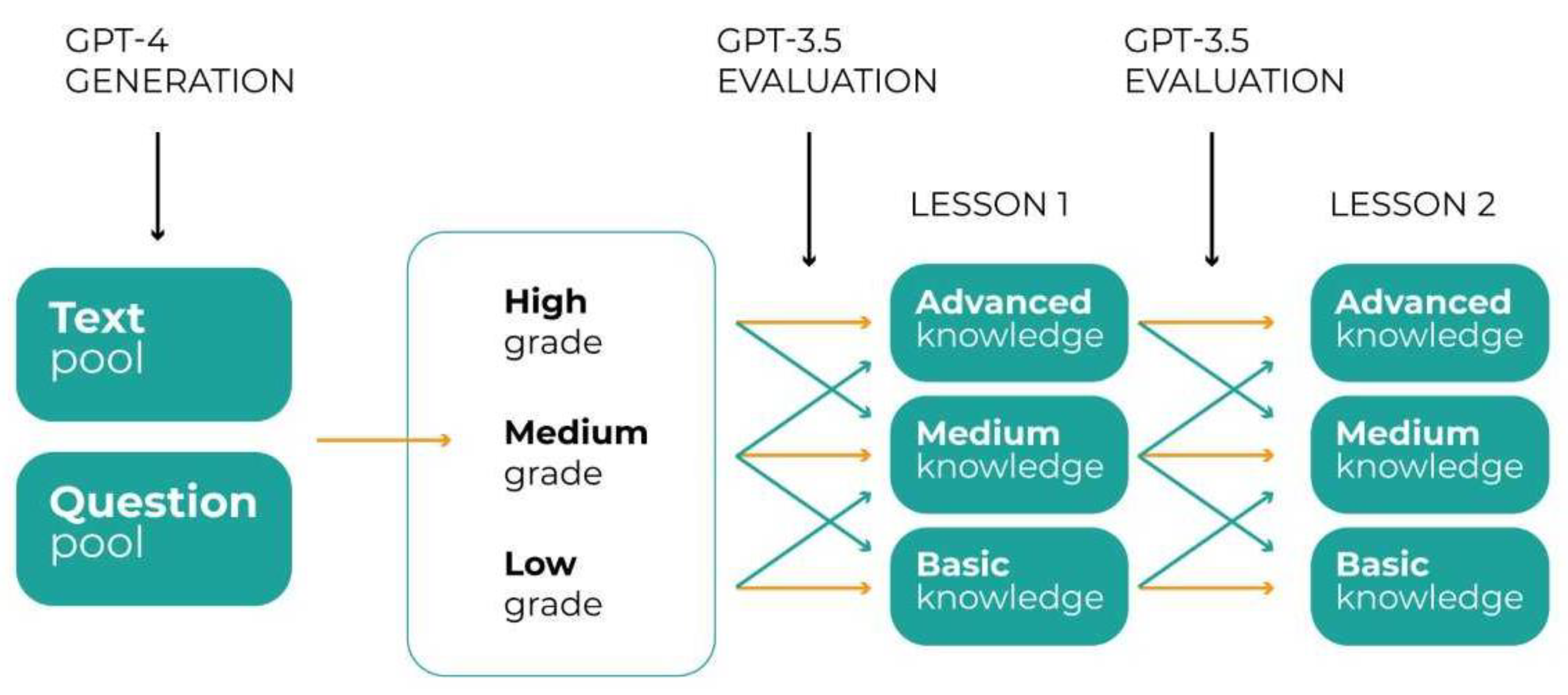Generative AI and ChatGPT in School Children’s Education: Evidence from a School Lesson
Abstract
:1. Introduction
2. Generative AI and the ChatGPT in School Education
2.1. Background of Generative AI in Education: Large Language Models (LLM) and Pre-Trained Language Models (PLM)
2.2. Current Practices of Generative AI in Education in Schools
3. Materials and Methods
Creating the Test Material
4. Results
4.1. Conducting the Introductory Part of the Test Lesson
4.2. Conducting the Content Part of the Test Lesson
4.3. Conducting the Self-Evaluation Part of the Test Lesson
4.4. Correctness of Pupils’ Answers to Questions Regarding the Test-Lesson Learning Material
5. Discussion
6. Conclusions
Author Contributions
Funding
Institutional Review Board Statement
Informed Consent Statement
Data Availability Statement
Conflicts of Interest
References
- Lo, C.K. What is the impact of ChatGPT on education? A rapid review of the literature. Educ. Sci. 2023, 13, 410. [Google Scholar] [CrossRef]
- Nahigian, T.J.; Fonseca, L. If you’re not first, you’re last: How AI becomes mission critical. Base 10. 17 November 2022. Available online: https://base10.vc/post/generative-ai-mission-critical/ (accessed on 15 July 2023).
- Jauhiainen, J.S.; Krohn, C.; Junnila, J. Metaverse and sustainability: Systematic review of scientific publications until 2022 and beyond. Sustainability 2023, 15, 346. [Google Scholar] [CrossRef]
- United Nations Department of Economic and Social Affairs. Sustainable Development Goal 4. In Ensure Inclusive and Equitable Quality Education and Promote Lifelong Learning Opportunities for All; United Nations: New York, NY, USA, 2022. [Google Scholar]
- Arpaci, I.; Kaya, A.; Bahari, M. Investigating the influence of an arduino-based educational game on the understanding of genetics among secondary school students. Sustainability 2023, 15, 6942. [Google Scholar] [CrossRef]
- Chen, C.-H.; Law, V.; Huang, K. The roles of engagement and competition on learner’s performance and motivation in game-based science learning. Educ. Technol. Res. Dev. 2019, 67, 1003–1024. [Google Scholar] [CrossRef]
- Giannini, S. The generative AI and the future of education. In ED/ADG; UNESCO: Geneva, Switzerland, 2023; Volume 2. [Google Scholar]
- Jeon, J.; Lee, S. Large language models in education: A focus on the complementary relationship between human teachers and ChatGPT. Educ. Inf. Technol. 2023, 8, 1–20. [Google Scholar] [CrossRef]
- Kasneci, E.; Sessler, K.; Küchemann, S.; Bannert, M.; Dementieva, D.; Fischer, F.; Gasser, U.; Groh, G.; Günnemann, S.; Hüllermeier, E.; et al. ChatGPT for good? On opportunities and challenges of large language models for education. Learn Indif. Differ. 2023, 103, 102274. [Google Scholar] [CrossRef]
- Jeon, J. Chatbot-assisted dynamic assessment (ca-da) for L2 vocabulary learning and diagnosis. Comput. Assist. Lang. L. 2022, 1–27. [Google Scholar] [CrossRef]
- Ali, S.; DiPaola, D.; Williams, R.; Ravi, P.; Breazeal, C. Constructing dreams using generative AI. Hum.-Comput. 2023. [Google Scholar] [CrossRef]
- Han, A.; Cai, Z. Design implications of generative AI systems for visual storytelling for young learners. In Proceedings of the IDC’23: Proceedings of the 22nd Annual ACM Interaction Design and Children Conference, New York, NY, USA, 19 June 2023; pp. 470–474. [Google Scholar] [CrossRef]
- Vartiainen, H.; Tedre, M. Using artificial intelligence in craft education: Crafting with text-to-image generative models. Digit. Creat. 2023, 34, 1–21. [Google Scholar] [CrossRef]
- Lozano, A.; Blanco Fontao, C. Is the education system prepared for the irruption of artificial intelligence? A study on the perceptions of students of primary education degree from a dual perspective: Current pupils and future teachers. Educ. Sci. 2023, 13, 733. [Google Scholar] [CrossRef]
- Bitzenbauer, P. ChatGPT in physics education: A pilot study on easy-to-implement activities. Contemp. Educ. Tech. 2023, 15, ep430. [Google Scholar] [CrossRef] [PubMed]
- Baidoo-Anu, D.; Ansah, L. Education in the Era of Generative Artificial Intelligence (AI): Understanding the Potential Benefits of ChatGPT in Promoting Teaching and Learning. 2023. Available online: https://ssrn.com/abstract=4337484 (accessed on 15 July 2023).
- Singh, A.; Kanaujia, A.; Singh, V.; Vinuesa, R. Artificial intelligence for Sustainable Development Goals: Bibliometric patterns and concept evolution trajectories. Sustain. Dev. 2023. [Google Scholar] [CrossRef]
- Digileac. Digital Learning Environments for All Contexts. Available online: https://sites.utu.fi/digileac (accessed on 15 July 2023).
- Statista. Number of Internet and Social Media Users Worldwide as of April 2023. Available online: https://www.statista.com/statistics/617136/digital-population-worldwide (accessed on 15 July 2023).
- United Nations. Sustainable Development Goals; United Nations: New York, NY, USA, 2022.
- Chang, C.; Kidman, G. The rise of generative artificial intelligence (AI) language models-challenges and opportunities for geographical and environmental education. Int. Res. Geogr. 2023, 32, 85–89. [Google Scholar] [CrossRef]
- Ahuja, K.; Diddee, H.; Hada, R.; Ochieng, M.; Ramesh, K.; Jain, P.; Nambi, A.; Ganu, T.; Segal, S.; Axmed, M. MEGA: Multilingual Evaluation of Generative AI. arXiv 2023, arXiv:2303.12528. [Google Scholar] [CrossRef]
- Su, J.; Yang, W. Unlocking the power of ChatGPT: A framework for applying generative AI in education. ECNU. Rev. Educ. 2023, 6, 355–366. [Google Scholar] [CrossRef]
- Floridi, L.; Chiriatti, M. GPT-3: Its nature, scope, limits, and consequences. Mind. Mach. 2020, 30, 681–694. [Google Scholar] [CrossRef]
- Aydın, Ö.; Karaarslan, E. Is ChatGPT Leading Generative AI? What is Beyond Expectations? 2023. Available online: https://ssrn.com/abstract=4341500 (accessed on 15 July 2023).
- Bonan, M.; Ross, H.; Sulem, E.; Veyseh, A.; Nguyen, T.; Sainz, O.; Agirre, E.; Heinz, I.; Roth, D. Recent advances in Natural Language Processing via large Pre-Trained Language Models: A survey. ACM. Comput. Surv. 2023, 56, 30. [Google Scholar] [CrossRef]
- Kaushal, A.; Mahowald, K. What do tokens know about their characters and how do they know it? arXiv 2022, arXiv:2206.02608. [Google Scholar] [CrossRef]
- Brown, T.; Mann, B.; Ryder, N.; Subbiah, M.; Kaplan, J. Language models are few-shot learners. Adv. Neural Inf. Process. Syst. 2020, 33, 1877–1901. [Google Scholar]
- Scao, T.; Fan, A.; Aikiki, C.; Pavlick, E.; Ilic, S.; Hesslow, D.; Castagné, R.; Luccioni, A.; Yvon, F.; Gallé, M.; et al. BLOOM: A 176B-parameter open-access multilingual language model. arXiv 2022, arXiv:2211.05100. [Google Scholar] [CrossRef]
- Ahuja, A.; Polascik, B.; Doddapaneni, D.; Byrnes, E.; Sridhar, J. The digital metaverse: Applications in artificial intelligence, medical education, and integrative health. Integr. Med. Res. 2023, 12, 100917. [Google Scholar] [CrossRef] [PubMed]
- OpenAI. Creating ADI That Benefits All of Humanity. 2023. Available online: https://openai.com (accessed on 15 July 2023).
- Dijkstra, R.; Zülküf, G.; Subhradeep, K.; Kamps, J. Reading comprehension quiz generation using Generative Pre-trained Transformers. Manuscript. 2022. Available online: https://intextbooks.science.uu.nl/workshop2022/files/itb22_p1_full5439.pdf (accessed on 15 September 2023).
- Ramesh, A.; Pavlov, M.; Goh, G.; Gray, S.; Voss, C.; Radford, A.; Chen, M.; Sutskever, A. Zero-shot text-to-image generation. Proc. 38th Int. Conf. Mach. Learn. 2021, 139, 8821–8831. [Google Scholar]
- Gattupali, S.; Maloy, R.W.; Edwards, S. Comparing teacher-written and AI-generated math problem solving strategies for elementary school students: Implications for classroom learning. Coll. Educ. Work. Pap. Rep. Ser. 2023, 5, 1–17. [Google Scholar] [CrossRef]
- Abdelghani, R.; Wang, Y.; Yuan, X.; Wang, T.; Luca, P.; Sauzéon, H.; Oyduer, P. GPT-3-driven pedagogical agents to train children’s curious question-asking skills. Int. J. of Artific. Intell. Educ. 2023, 1–36. [Google Scholar] [CrossRef]
- Ji, H.; Han, I.; Ko, Y. A systematic review of conversational ai in language education: Focusing on the collaboration with human teachers. J. Res. Technol. Educ. 2023, 55, 48–63. [Google Scholar] [CrossRef]
- Berlin, C.; Adams, C. Production Ergonomics: Designing Work Systems to Support Optimal Human Performance; Ubiquity Press: London, UK, 2017. [Google Scholar]
- UNESCO. Recommendation on the Ethics of Artificial Intelligence; UNESCO: Geneva, Switzerland, 2021.
- Statista. Languages Most Frequently Used for Web Content as of January 2023, by Share of Websites. Available online: https://www.statista.com/statistics/262946/most-common-languages-on-the-internet/ (accessed on 15 July 2023).
- Emma Groeneveld. Las Sociedades Cazadoras-Recolectoras de la Prehistoria. World History Encyclopedia. Translated into Spanish by Waldo Reboredo Arroyo. 2023. Available online: https://www.worldhistory.org/user/emmagroeneveld1/ (accessed on 15 July 2023).
- Tessa Kiss. Indígenas. Enciclopedía Humanidades. 2023. Available online: https://humanidades.com/indigenas/ (accessed on 15 July 2023).
- Tessa Kiss. Imperio Romano. Enciclopedía Humanidades. 2023. Available online: https://humanidades.com/imperio-romano/ (accessed on 15 July 2023).
- Nakamura, J.; Cziksentmihalyi, M. Flow theory and research. In The Oxford Handbook of Positive Psychology, 2nd ed.; Lopez, S., Snyder, C., Eds.; Oxford University Press: Oxford, UK, 2009; pp. 195–206. [Google Scholar]



| All Pupils | Boys | Girls | Excellent or Good Knowledge | Much or Somewhat Interest | Pupils N | |
|---|---|---|---|---|---|---|
| Excellent or good school mark, average | 73.6 | 76.2 | 73.3 | 91.0 | 85.3 | 81 |
| Medium mark, average | 25.5 | 23.8 | 24.4 | 9.0 | 14.7 | 28 |
| Satisfactory or poor school mark, average | 0.9 | 0.0 | 2.2 | 0.0 | 0.0 | 1 |
| Excellent or good knowledge in topic | 30.0 | 25.3 | 35.5 | - | 55.9 | 33 |
| Medium knowledge of topic | 31.8 | 39.7 | 22.2 | - | 26.5 | 35 |
| Satisfactory or poor knowledge in topic | 38.2 | 34.9 | 42.2 | - | 17.6 | 42 |
| Much or some interest in topic | 30.0 | 31.7 | 28.6 | 57.6 | - | 34 |
| Fair interest in topic | 29.1 | 30.2 | 28.9 | 27.2 | - | 32 |
| Little or no interest in topic | 40.0 | 38.1 | 42.3 | 15.2 | - | 44 |
| Mean Time Used for Answering | Standard Deviation | Standard Error | 1st Set Open Questions | 1st Set Multiple Choice | 2nd Set Open Questions | 2nd Set Multiple Choice | Pupils N | |
|---|---|---|---|---|---|---|---|---|
| 4th-grade pupils | 292.76 | 131.78 | 18.64 | 133.38 | 29.92 | 90.60 | 38.86 | 50 |
| 5th-grade pupils | 452.72 | 202.25 | 35.75 | 198.56 | 82.38 | 110.69 | 61.09 | 32 |
| 6th-grade pupils | 275.90 | 126.38 | 23.88 | 103.68 | 41.00 | 90.29 | 40.93 | 28 |
| Average | 355.55 | 153.47 | 26.09 | 144.74 | 48.00 | 116.96 | 45.85 | 110 |
| Very Easy | Quite Easy | Neither Easy nor Difficult | Quite Difficult | Very Difficult | |
|---|---|---|---|---|---|
| Basic knowledge group | 17.2 | 24.1 | 48.3 | 6.9 | 3.4 |
| Intermediate knowledge group | 2.8 | 37.5 | 27.8 | 25.0 | 6.9 |
| Advanced knowledge group | 22.2 | 22.2 | 33.3 | 22.2 | 0.0 |
| Very Much Learning | Much Learning | Some Learning | Little Learning | Not at All Learning | Pupils N | |
|---|---|---|---|---|---|---|
| 4th-grade pupil | 20.0 | 40.0 | 28.0 | 10.0 | 2.0 | 50 |
| 5th-grade pupil | 34.4 | 31.3 | 28.1 | 3.1 | 3.1 | 32 |
| 6th-grade pupil | 17.9 | 25.0 | 32.1 | 14.3 | 10.7 | 28 |
| Boys | 17.5 | 33.3 | 38.1 | 7.9 | 3.2 | 63 |
| Girls | 33.3 | 35.6 | 17.8 | 8.9 | 4.4 | 45 |
| Much interest in the topic | 70.6 | 17.6 | 5.9 | 5.9 | 0.0 | 17 |
| Little interest in the topic | 23.5 | 47.1 | 29.4 | 0.0 | 0.0 | 17 |
| Not at all interested in the topic | 0.0 | 29.6 | 40.7 | 14.6 | 14.8 | 27 |
| Perceived having much or some knowledge on the topic | 42.2 | 36.4 | 15.2 | 3.0 | 3.0 | 33 |
| Perceived having little or no knowledge on the topic | 14.3 | 28.6 | 38.1 | 9.5 | 9.5 | 42 |
| Performed best in the test (over 75% answers correct) | 20.0 | 40.2 | 33.3 | 0.0 | 6.7 | 15 |
| Performed poorest in the test (less than 50% correct) | 24.1 | 24.1 | 34.5 | 10.3 | 6.9 | 29 |
| Enjoyed the test much or very much | 32.9 | 38.4 | 21.9 | 6.8 | 0.0 | 73 |
| Enjoyed the test little | 0.0 | 33.3 | 33.3 | 16.7 | 16.7 | 6 |
| Enjoyed the test not at all | 0.0 | 0.0 | 20.0 | 20.0 | 60.0 | 5 |
| Average | 23.6 | 33.6 | 29.1 | 9.1 | 4.5 | 110 |
| Mean | Standard Deviation | Standard Error | Pupils N | |
|---|---|---|---|---|
| 4th-grade boy pupils | 3.39 | 0.99 | 0.19 | 28 |
| 4th-grade girl pupils | 3.82 | 1.14 | 0.24 | 22 |
| 5th-grade boy pupils | 4.05 | 1.09 | 0.23 | 22 |
| 5th-grade girl pupils | 4.80 | 0.63 | 0.20 | 10 |
| 6th-grade boy pupils | 3.69 | 1.44 | 0.44 | 14 |
| 6th-grade girl pupils | 3.77 | 1.01 | 0.28 | 14 |
| Correct Answers (N) | Correct Answers (%) | Pupils N | |
|---|---|---|---|
| Perceived having much knowledge on the topic | 3.68 | 46.0 | 22 |
| Perceived having some knowledge on the topic | 4.65 | 58.1 | 20 |
| Perceived having fair knowledge on the topic | 5.14 | 64.3 | 35 |
| Perceived having little knowledge on the topic | 5.13 | 64.1 | 23 |
| Perceived having no knowledge at all on the topic | 4.10 | 51.3 | 10 |
| Multiple-Choice Questions | Open-Ended Questions | |||||
|---|---|---|---|---|---|---|
| Correct Answers (%) | Correct Answers (N) | Total Answers (N) | Correct Answers (%) | Correct Answers (N) | Total Answers (N) | |
| 11–20 s | 100.0 | 4 | 4 | - | - | - |
| 21–40 s | 92.6 | 63 | 68 | 25.0 | 1 | 4 |
| 41–80 s | 80.2 | 138 | 172 | 50.0 | 8 | 16 |
| 81–160 s | 72.2 | 93 | 128 | 36.5 | 35 | 96 |
| 161–320 s | 65.6 | 42 | 64 | 36.3 | 74 | 204 |
| 321–500 s | - | - | - | 41.3 | 33 | 80 |
| More than 500 s | 25.0 | 1 | 4 | 52.5 | 21 | 40 |
Disclaimer/Publisher’s Note: The statements, opinions and data contained in all publications are solely those of the individual author(s) and contributor(s) and not of MDPI and/or the editor(s). MDPI and/or the editor(s) disclaim responsibility for any injury to people or property resulting from any ideas, methods, instructions or products referred to in the content. |
© 2023 by the authors. Licensee MDPI, Basel, Switzerland. This article is an open access article distributed under the terms and conditions of the Creative Commons Attribution (CC BY) license (https://creativecommons.org/licenses/by/4.0/).
Share and Cite
Jauhiainen, J.S.; Guerra, A.G. Generative AI and ChatGPT in School Children’s Education: Evidence from a School Lesson. Sustainability 2023, 15, 14025. https://doi.org/10.3390/su151814025
Jauhiainen JS, Guerra AG. Generative AI and ChatGPT in School Children’s Education: Evidence from a School Lesson. Sustainability. 2023; 15(18):14025. https://doi.org/10.3390/su151814025
Chicago/Turabian StyleJauhiainen, Jussi S., and Agustín Garagorry Guerra. 2023. "Generative AI and ChatGPT in School Children’s Education: Evidence from a School Lesson" Sustainability 15, no. 18: 14025. https://doi.org/10.3390/su151814025
APA StyleJauhiainen, J. S., & Guerra, A. G. (2023). Generative AI and ChatGPT in School Children’s Education: Evidence from a School Lesson. Sustainability, 15(18), 14025. https://doi.org/10.3390/su151814025








